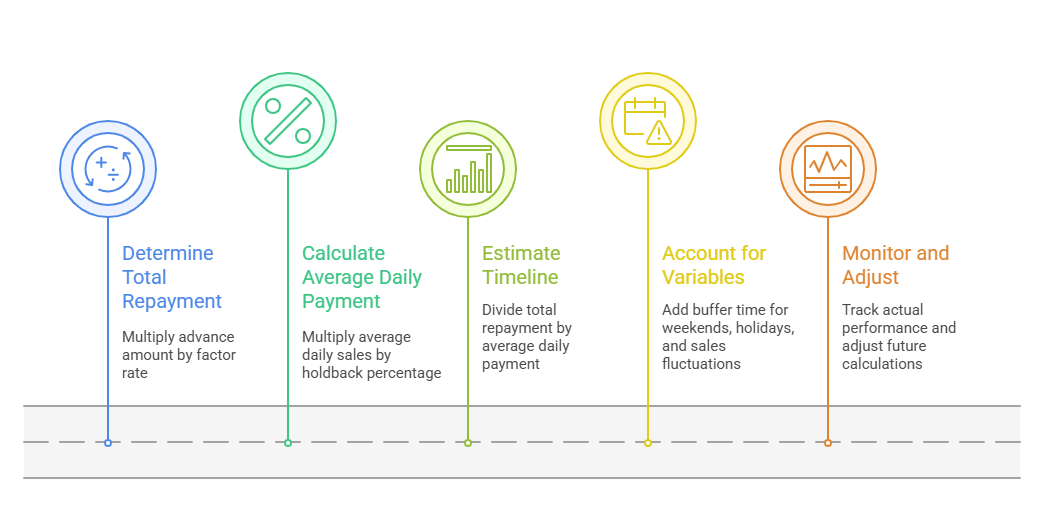Understanding Your Merchant Cash Advance Payment Schedule
When you're considering merchant cash advance funding for your business, understanding exactly how to calculate repayment timeline for merchant funding becomes crucial for maintaining healthy cash flow. Unlike traditional financing options, merchant cash advances operate on a unique repayment structure that's directly tied to your daily sales performance. This funding option might seem straightforward at first glance, but the calculation involves several key components that work together to determine your payment schedule.
The repayment timeline for merchant funding depends on multiple factors including your factor rate, holdback percentage, and daily sales volume. These elements create a flexible payment system that adjusts with your business's revenue patterns. However, this flexibility also means you'll need to understand the underlying calculations to forecast your cash flow effectively and avoid potential shortfalls in your operating budget.
Essential Components for Timeline Calculations
Essential components for timeline calculations form the foundation of understanding how merchant cash advances work. Before you can accurately predict your repayment schedule, you'll need to grasp these fundamental elements that determine your payment structure.

- Factor Rate: This multiplier typically ranges from 1.1 to 1.5 and determines your total repayment amount when multiplied by the advance amount
- Holdback Percentage: Usually between 5% to 20% of daily sales, this represents the portion of daily revenue that goes toward repayment
- Daily Sales Volume: Your average daily credit card and debit card sales, which directly impacts how quickly you'll repay the advance
- Total Repayment Amount: Calculated by multiplying the advance amount by the factor rate to determine the full amount you'll pay back
Factor Rate Formula Breakdown
The factor rate formula breakdown helps you understand the true cost structure of your merchant cash advance. This calculation method differs significantly from traditional interest rates and requires a specific approach to determine your total financial commitment.
- Basic Calculation: Multiply your advance amount by the factor rate (e.g., $50,000 × 1.3 = $65,000 total repayment)
- Cost Assessment: Subtract the original advance from the total repayment to find the fee amount ($65,000 - $50,000 = $15,000)
- Percentage Cost: Divide the fee by the advance amount to understand the percentage cost (($15,000 ÷ $50,000) × 100 = 30%)
- Timeline Impact: Higher factor rates mean larger total repayments but don't directly affect the repayment speed, which depends on sales volume
Holdback Percentage Impact on Payments
Holdback percentage impact on payments determines how much of your daily sales revenue gets automatically deducted for advance repayment. This percentage directly affects your cash flow and repayment timeline, making it a critical factor in your financial planning.
- Daily Deduction Amount: Calculate by multiplying daily sales by the holdback percentage (e.g., $2,000 daily sales × 15% = $300 daily payment)
- Cash Flow Planning: Higher holdback percentages mean faster repayment but less daily working capital for business operations
- Sales Fluctuation Buffer: Lower sales days result in smaller deductions, providing natural protection during slow periods
- Weekend and Holiday Considerations: No sales typically means no deductions, extending the overall repayment timeline during these periods
Step-by-Step Timeline Calculation Process
The step-by-step timeline calculation process provides a systematic approach to determining how long your merchant cash advance repayment might take. This methodical calculation helps you forecast your payment schedule with greater accuracy.

- Determine Total Repayment: Multiply your advance amount by the factor rate to establish the full amount you need to pay back
- Calculate Average Daily Payment: Multiply your average daily sales by the holdback percentage to find typical daily deduction amounts
- Estimate Timeline: Divide the total repayment amount by the average daily payment to get an approximate number of business days
- Account for Variables: Add buffer time for weekends, holidays, and potential sales fluctuations that may extend the timeline
- Monitor and Adjust: Track actual performance against projections and adjust future calculations based on real sales data
Daily Deduction Calculation Methods
Daily deduction calculation methods help you understand exactly how much money gets withdrawn from your account each business day. These calculations form the backbone of your repayment timeline and cash flow management strategy.
- Fixed Percentage Method: Apply the same holdback percentage to all daily sales regardless of volume fluctuations
- Split Processing: Some providers may use different percentages for credit card versus debit card transactions
- Weekend and Holiday Rules: Understand whether deductions occur on non-business days or if they're deferred to the next business day
- Minimum Payment Thresholds: Check if your agreement includes minimum daily payment requirements even during low-sales periods
- Maximum Daily Caps: Some agreements may limit daily deductions to protect your working capital during high-sales days
Planning for Payment Success
Planning for payment success requires careful consideration of how merchant cash advance repayments will integrate with your existing business operations and cash flow patterns. Understanding how to calculate repayment timeline for merchant funding gives you the foundation to make strategic decisions that support your business's financial health. The key lies in balancing the immediate capital injection with the ongoing payment obligations that will affect your daily operations.
Successful merchants typically create detailed projections that account for seasonal variations, unexpected sales dips, and the need for working capital reserves. This proactive approach helps ensure that the advance serves its intended purpose of supporting business growth rather than creating cash flow challenges. By accurately forecasting your repayment timeline, you can better align your business strategies with your payment obligations and maintain the financial flexibility needed to capitalize on growth opportunities.
Mastering the calculation of your merchant cash advance repayment timeline empowers you to make informed financing decisions that align with your business goals. The combination of factor rates, holdback percentages, and daily sales projections creates a framework that helps you predict both the cost and duration of your funding commitment. This knowledge becomes invaluable when comparing different funding options or planning for future capital needs.
Remember that these calculations provide estimates based on projected sales performance, and actual timelines may vary depending on your business's day-to-day revenue fluctuations. Regular monitoring and adjustment of your projections will help you stay on track and maintain the cash flow balance necessary for continued business success. With these calculation methods in your toolkit, you're better equipped to leverage merchant cash advances as an effective funding solution for your growing business.

.png)






